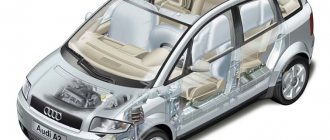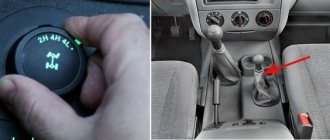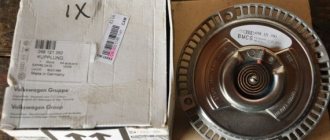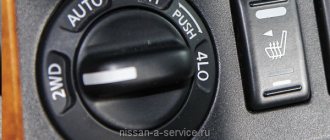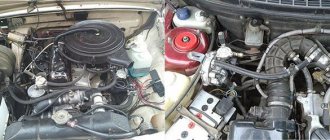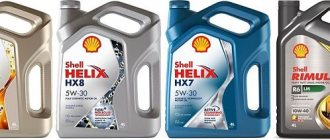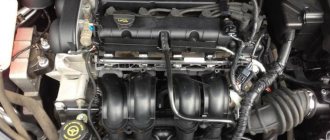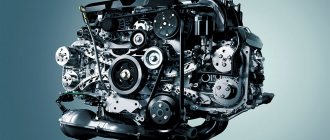For most, all-wheel drive is when all four wheels are driving. However, digging a little deeper, we find that even if the car has an AWD , this does not mean that the torque from the engine is supplied to both axles. We decided to figure out what all-wheel drive systems are today and what technical problems they entail, together with the technical specialists of the service concern VAG .
Today in the civilian automotive industry there are two main types of all-wheel drive: part-time and full-time. Conventional subtypes include electronically controlled all-wheel drive (On-demand) and multifunctional all-wheel drive, which, as a rule, has its own name for different brands.
Hard-wired or Part-time all-wheel drive
This type of drive is considered the simplest and most reliable, since it does not have any complex systems that should be responsible for the automatic distribution of traction along the axes. By default, torque is transmitted to only one axle, the second axle is engaged only when needed using a transfer case with a dog clutch. When the transfer case is turned on, both axles are rigidly connected to each other, ensuring a constant symmetrical distribution of torque.
Despite its design simplicity, the system has a significant feature: the inability to drive in all-wheel drive mode all the time, as well as at high speeds and on flat, dry surfaces. Or rather, you can drive it, only with a huge probability of damaging the all-wheel drive system.
The fact is that when turning, each of the four wheels rotates at different speeds and follows its own turning path. There are no systems between the axles that compensate for the difference in these speeds, and therefore the entire load falls on the transfer case, which eventually fails. Simply put, connecting a second axle is only necessary to increase the vehicle’s maneuverability on surfaces that allow wheel slippage, such as mud, sand, snow, ice or, in extreme cases, heavy rain.
Problems
As for technical problems, the main reason for the failure of the transfer case is precisely the neglect of the rules for using all-wheel drive. For example, the transfer case regularly breaks down on Suzuki Jimny cars due to the fact that the main consumers of this car are representatives of the fair half of humanity, who do not particularly understand the design nuances of the Part-time system.
If hard activation occurs not with the good old lever, but with the help of an electric drive, then the system may not turn on. This happens most often when the car is stationary, because the teeth of the shafts do not engage the hook and the electronics give up. This is not a malfunction and can be corrected simply by coasting, so that at the moment of movement the hook still occurs.
Very often, cars with the Part-time system are the objects of serious off-road tuning, and therefore the most severe loads. So, collapsed cross-axle differentials, a broken front shaft chain and changed final drives are not uncommon on such cars. However, in most cases, the unit is so simple and reliable that it can only raise questions in the case of huge mileage or negligence of the owner, for example, when changing the oil.
Cars with the Part - time include most modern pickups and serious SUVs: UAZ Patriot, Toyota Hilux , Foton Sauvana and even Suzuki Jimny . As a rule, most cars with a similar system have an additional reduction gearbox in the transfer case, as well as rear cross-axle locking - standard or as an option
Design and principle of operation
The viscous clutch operates on the same principle as a torque converter in an automatic transmission. In both cases, torque is transmitted through a fluid. However, the clutch is designed a little differently than the torque converter. It is a hermetically sealed enclosure. Driver and driven impellers (two turbines) rotate inside it. When the wheel shafts rotate synchronously, the composition inside is in a liquid state. As soon as one axle slips, the torque of one turbine is transferred to the other. The liquid mixes and becomes solid. Thus, the transmission of torque to the axle is resumed. As soon as the car has overcome the obstacle, the mixing stops. The torque is again transmitted to one axle.
But this is not a single design diagram for a viscous coupling. Some have driving and driven friction discs instead of turbines (see photo below).
They work on the same principle. Dilatant liquid is also poured inside. When the shafts rotate at different speeds, it mixes and becomes dense (and expands). So, the torque is equalized, and both wheels (front and rear) rotate equally. Due to the expansion of the fluid, the driven and driving disks are pressed against each other.
As you can see, the mechanism is quite simple. The element lasts quite a long time, so repair of the viscous coupling may not be necessary soon.
Automatic or On-demand all-wheel drive
The most widespread type of all-wheel drive, which is based on a multi-plate clutch capable of transferring torque from the main drive axle to the auxiliary one. This type of drive is not a serious off-road weapon (although there are exceptions) and serves more as an additional system for more confident movement over uneven surfaces and more efficient distribution of torque across the wheels depending on the type of surface.
By default, the On-demand system operates in single-drive mode. As soon as the electronics receives a signal that the drive wheels are slipping, torque is supplied to the second axle using an electronically controlled multi-plate clutch. Additionally, with the help of auxiliary electronic systems, the torque on each wheel can be adjusted.
Structurally, the system operates on the clutch principle: inside the clutch there are disks, which, when a signal is received from the sensors, are mechanically pressed against each other, transmitting torque to the driven axle. Systems of different brands differ mainly in the principle of pressing these disks and the “sophistication” of the electronic “brains” of the drive, which is expressed in speed or the presence of various manual activation modes. Simple systems rely, for example, on information from ABS and ESP sensors, while premium crossovers are able to monitor indicators such as steering angle, body roll, etc.
Problems
Considering that the principle of operation of the friction clutch is based on friction, the main problem of the On-demand system is overheating, at which point the system generates an error and disables the driven axle. In most cases, it occurs during prolonged slipping, for example, when trying to conquer any off-road conditions, sometimes even the most harmless ones. As a rule, when it cools down, the coupling becomes operational again. Regular repetition of this leads to replacement of the clutch pack.
Another common problem is the failure of the clutch housing bearing, the signs of wear of which are noise, howling or vibration. Of course, the condition and level of oil in the coupling also greatly affects the performance of the drive. The serviceability of the sensors from which the clutch “brains” receive information directly affects the activation of all-wheel drive. You can also often encounter a malfunction of the drive mechanism that compresses the disks.
In general, we can say that, although the On-demand system has been well studied and is well known to mechanics, it is quite capricious and expensive to repair. The good news is that most of the problems of the friction clutch are associated with its harsh use, that is, when city crossovers begin to be used as SUVs. If all-wheel drive is used from time to time in light mode, the system causes almost no problems.
Cars with the On - demand include most modern crossovers: Nissan X - Trail , Kia Sportage , Mitsubishi Outlander . However, there are various interesting exceptions. For example, Renault Duster received an imitation of a reduction gear in pair with a regular clutch, and Nissan Juke generally has a system of two independent clutches on each of the rear wheels
Manual all-wheel drive
In the classic version, the system has almost the same design as a transmission with permanent all-wheel drive.
- Transmission.
- Transfer case.
- Clutch.
- Cardan axle transmissions.
- Main axle gears.
- Cross-wheel differentials.
- Wheel axles.
This type of transmission is not used in modern cars. This system has a very low efficiency rate. Its only advantage is that it provides a 50/50 distribution of torque between the axles, which is not available with any other type of transmission. Therefore, it is considered ideal for powerful SUVs.
Principle of operation:
The operating principle of a manually engaged all-wheel drive transmission is similar to a system with permanent all-wheel drive. The only thing is that the transfer case is controlled directly from inside the car using a special lever.
One of the most serious disadvantages of the system is the inability to use it for a long period of time. This means that it can be connected temporarily if it hits a slippery or wet surface, but then it should be turned off immediately. Long-term use of such a transmission leads to increased vibration, noise and fuel consumption.
All-wheel drive cars in our country enjoy honor and respect, but at the same time, the much-coveted 4x4 scheme can be implemented in different ways. Let's consider the advantages and disadvantages of schemes with mechanical interaxle blocking and blocking using an electronically controlled clutch.
Historically, the all-wheel drive scheme appeared first, in which a transfer case was added to the transmission of a rear-wheel drive car, and from it a driveshaft was extended to the front (now also drive) axle. In this case, the connection of the front axle was carried out as necessary and “rigidly”. The transmissions of many “professional” all-terrain vehicles are still made according to this scheme. Among the domestic ones we can name the entire UAZ family. There are also many imported ones - from the compact Suzuki Jimny to the legendary Land Rover Defender.
And if off-road such “rogues” have no equal, then in the city, you must admit, it’s not very easy to cope with them. Therefore, the designers proposed a more convenient and practical technical solution. This is an all-wheel drive scheme in which torque was transmitted to both axles through a differential. Typical representatives are domestic Lada 4x4 and Chevrolet Niva.
Permanent all-wheel drive with lockable center differential
The Chevrolet Niva has permanent all-wheel drive - torque from the engine is always transmitted to both axles (the axles are not disabled). This scheme increases the vehicle’s cross-country ability, while simultaneously reducing the load on the transmission units, but slightly increases fuel consumption.
The front and rear axles are connected through a center differential, allowing the front and rear wheels to rotate at different angular speeds depending on the trajectory and driving conditions. The center differential is located in the transfer case. It is similar to the inter-axle differentials in the front and rear axles, but unlike them, the inter-axle differential can be forcibly locked. In this case, the drive shafts of the front and rear axles become rigidly connected to each other and rotate at the same frequency. This significantly increases the vehicle's maneuverability (on slippery slopes, in mud, snow, etc.), but worsens handling and increases wear on transmission parts and tires on surfaces with good grip. Therefore, the differential lock can only be used to overcome difficult areas and at low speeds.
You can turn on the lock while the car is moving, if the wheels do not slip. But this will not eliminate the danger of “diagonal hanging”, when one of the wheels on each axle loses traction with the ground - in this case, you will have to add soil under the suspended wheels or dig it under the others. To increase the torque supplied to the wheels, a low gear in the transfer case is used, its gear ratio is 2.135. The highest gear, intended for normal driving conditions, has a gear ratio of 1.20.
All-wheel drive transmission with electromagnetic rear wheel coupling
However, progress did not stand still - the designers proposed an idea that was brilliant in terms of simplicity of execution and profitability: to create a crossover based on a front-wheel drive car. The recipe is similar for all automakers. Let's consider this scheme in detail using the example of the Renault Duster model.
The engine and gearbox (manual or automatic) are mounted transversely to the vehicle. All shafts inside the gearbox, respectively, too. And the torque needs to be transmitted to the rear axle. To do this, they used an angular gearbox at the front and a cardan shaft, which, in turn, is connected to a coupling. The driving part of the coupling in conjunction with the propeller shaft rotates whenever the front gearbox gear rotates. The driven part of the clutch is connected by splines to the shaft of the main gear drive gear. The electromagnetic clutch housing is also attached to the main gear housing: an angular gearbox combined with a differential. From the differential, the drives transmit torque directly to the rear wheels. The clutch is equipped with an electronic control unit, which, in turn, depends on the transmission mode switch on the instrument panel console. This is how the all-wheel drive scheme of most modern crossovers with a transverse power unit looks like in a simplified manner.
To control the compression force of the clutch discs, a cam mechanism is used that changes the clamping force. The voltage applied to the clutch solenoid causes the clutch discs to close and engage the rear axle. The amount of transmitted torque is regulated by the adhesion force of the friction discs in the clutch. So, if the voltage supplied to the electromagnet is reduced, the clutch will provide an incomplete circuit and will be able to rotate with a small torque. However, even with full voltage applied, a closed clutch can transmit a torque limited by the friction forces in the clutch.
For the clutch to operate, there needs to be at least a slight “lag” between the rear wheels and the front wheels. The most interesting thing is that there are no temperature sensors in the clutch, and it turns off “due to overheating” when the control unit, through the ABS sensors, records for some time that with full voltage on the clutch, the rear wheels do not rotate, but the front wheels rotate at a significant speed. So in most cases, electronics simply play it safe.
What to choose?
In both schemes, all drive and driveshafts rotate constantly, so there is no difference in terms of fuel consumption. A scheme with a rigid clutch lock is preferable on severe off-road conditions, since electronically controlled clutches are capable of transmitting only a limited torque, and when the clutches slip, they are prone to rapid “overheating,” albeit often virtual. Unexpected automatic engagement of the clutch while cornering can sometimes be dangerous.
From personal experience
Having owned a car with an electromagnetic clutch for connecting the rear axle, I can tell you what modes I use. In the summer, on paved roads, the 2WD mode is always on; in mud, I use its full potential and turn off the ESP dynamic stabilization system. In winter, the AUTO mode is always on. First of all, to avoid losing the studs on the front wheels. Tests show that the loss of studs is especially high when the drive wheels slip. If sharp acceleration is necessary in winter, and the surface under the wheels is of poor quality, for example, tram track tiles, then I turn on the LOCK mode. And if you need to get out of a snowdrift, use LOCK mode and turn off ESP.
I also used Niva. So, if it was necessary to start on a slippery surface, I turned on the lock, and in dense traffic jams I crawled on a lower one - this way the load on the clutch is less.
“Honest all-wheel drive” is a vague but convincing term, the sacred mantra of Internet gurus. However, today the vast majority of manufacturers rely on electronics and multi-plate clutches that automatically connect the rear axle...
It’s good to have a 4x4 car in case of a snow storm, and the rest of the time - an economical single-wheel drive. And when starting off on wet asphalt, it’s useful to be fully prepared. But just a moment later, when the speed is picked up, an extra drive axle is just a waste of fuel.
This is a 100% crossover format, and in order to make quick or short-term engagement of the second pair of drive wheels possible, various multi-plate clutches for connecting them have appeared.
SAVING METAL AND FUEL
An inexpensive and compact multi-plate clutch, which does not cause additional vibrations and is extremely responsive, has replaced all other types of transmissions in 90% of all-wheel drive vehicles today, reducing the formula for the current construction of a mass crossover to a single principle: a transversely located motor in front constantly drives the front wheels, and the rear ones are connected by a clutch along needs.
All-wheel drive implemented in this way is much simpler than real off-road designs. There is no transfer case, only an additional pair of power take-off gears and an output shaft remain near the front differential. Another plus: thanks to the low weight and size, it became possible to relieve the already heavy front part of the car from the weight of the coupling. The multi-plate clutch is located directly on the rear gearbox.
DIFFERENT
But the clutch is different from the clutch. With the same principle for connecting the second bridge, the designs may have significant differences.
Initially, it was decided to somehow force the clutch to operate by slipping the front half, connected to the engine and front wheels, relative to the rear half, connected to the rear wheels. The front began to skid, the speed difference between the halves began to change, the clutch locked, and the rear engaged. Logical?
The very first couplings were used by Volkswagen Golf in its Syncro transmission. The clutch pack in them did not compress, but was filled with silicone liquid, which thickened under heavy loads and transmitted rotation itself. It was impossible to control such a visco coupling; its performance left much to be desired, and it could not transmit 100% of the torque to the rear wheels. In addition, when slipping in mud, the silicone boiled, the coupling quickly overheated and... burned out.
Another design found its way onto early Ford Escapes. There the clutch discs were already compressed, but this happened purely mechanically, with the help of balls and wedge-shaped slots, at the moment of turning the front part relative to the rear. The clutch worked more clearly, but sharply, causing unexpected impacts in the most critical phase of a slippery turn.
Imagine that in a bend your car will suddenly turn from front-wheel drive to “classic”, and when you release the gas, the clutch will also suddenly disengage. The consequences can be fatal.
This problem continued to plague coupling manufacturers for quite some time. In order to more adequately regulate the flow of power to the rear wheels, and at the same time protect the clutch discs from overheating, an attempt was made to use hydraulics.
THE COMING OF HALDEX
The latest version of the uncontrolled clutch was the first generation of Haldex in 1998. Here the discs were compressed by a hydraulic cylinder, the oil pressure for which was generated by a pump. The pump was mounted on one half of the coupling, and the drive came from the other. That is, now, with a difference in the speed of the front and rear wheels, the compression pressure increased and the clutch was blocked. Haldex worked gently and was successful.
There were two benefits at once: the oil, now circulating through the hydraulic pump, was cooled better, and the hydraulic drive worked more clearly and, most importantly, faster. But still, part of the drive functionality remained unused - anticipating the connection of the rear axle at the very beginning of the development of a dangerous situation, partially blocking the clutch for cornering. Electronics could and should have handled this.
So in 2004, the second generation of Haldex appeared with the same discs and pump, but with an electronic valve, and a department in charge of all-wheel drive was introduced into the “brains” of the car’s stabilization system.
Compact. The entire set of Haldex clutch elements is assembled into a dense block and is only slightly larger in size than a standard differential
The system became controllable, and the torque transmitted back was no longer directly dependent on the difference in speed of the front and rear wheels. FOREWARNED IS FOREARMED
Everything would be fine, but situations remained “unaffected” in which it would be good to have full-fledged all-wheel drive before the front wheels started slipping. In other words, a pump operating from the difference in speed of the clutch halves no longer suited transmission engineers. After all, its life-saving pressure was simply absent in some driving modes.
The solution turned out to be simple and, in general terms, is still used today in most drives implemented using a clutch.
The next - fourth - generation of Haldex received an externally attached electric pump and the already familiar control valves in front of the hydraulic cylinders. Now, at any time, the clutch could be fully or partially closed only by an electronic signal.
This principle has had a lot of positive effects. Standstill start modes have appeared, in which the clutch is completely blocked for a short period of acceleration. Significant locking modes have been added in corners, when good grip on dry asphalt allows you to use all-wheel drive to the fullest.
Surprisingly, all-terrain qualities have increased. After all, it has now become possible by simply pressing a button to switch the clutch operation algorithm from “asphalt” to “off-road” or entrust this task to automation.
Do you recognize the three main operating modes of your crossover's transmission? Of course, you have exactly such a clutch in the rear wheel drive!
Just a moment. Two components of the system's performance are an electronic brain and an ultra-fast solenoid valve, the opening time of which is less than 0.1 s.
FURTHER MORE
Electronic clutch control has become conveniently combined with both the stabilization system and the clutch’s own safety program. A small temperature sensor inside the clutch now monitored the operating temperature and turned off the drive if the clutches were close to overheating. Of course, a car that has become underpowered for ten minutes can throw you off balance, but this is incomparably better than smoke from under the bottom and a transmission breakdown.
In addition, the more crossovers with electronically controlled clutches ended up in the hands of owners, the wider and more precise the programs for all-wheel drive systems became. Today, the best of them are no longer afraid of overheating not only in loose snow, but also in outright muddy skidding. And chemists and materials scientists did not sit idle. New materials for discs and linings made it possible to double the emergency shutdown temperature, as well as increase the torque transmitted by the clutches to values that are obviously greater than the motor can produce.
Modern friction materials, high-quality oils and advanced disk closure control programs make it possible to even keep the clutch partially connected without fear of overheating. At the same time, the car receives a distribution of torque along the axles in a ratio of 10:90, or even 40:60, which for brands that gravitate towards a rear-wheel drive layout allows you to combine classic road manners with light all-wheel drive, sometimes almost imperceptible. And even continuously vary the degree of connection, improving the car’s handling and helping the stabilization system do its job.
Considering the flexibility of the operating algorithms and the high degree of perfection in the design of multi-disc clutches, today this is the most widespread option for organizing all-wheel drive and it is unlikely that anything fundamentally new awaits us here in the foreseeable future.
Now a very large number of so-called crossovers have not entirely honest all-wheel drive. It is not permanent, and it can also be connected for a very short time (I would like to note that it is connected automatically) - whether this is good or bad, we will definitely talk about it in another article, today I want to talk about “automatic connection” using a “viscous coupling” - and what is it You know? After all, this unit is now in great demand, but unfortunately many simply do not understand the principle of its operation, although everyone knows this name. Well, as usual, I figured out the topic and will try to tell you in detail what it is and how everything actually works, there will be a detailed video at the end, so read and watch...
To be fair, I would like to note that viscous couplings are used not only in all-wheel drive systems, but also in car cooling systems and more. To begin with, as usual, a definition.
Viscous coupling (or viscous coupling)
is an automatic device for transmitting torque using the viscous properties of special fluids.
To put it simply, torque is transmitted by changing the viscosity of a special fluid in the viscous coupling body.
All-wheel drive based on Haldex coupling
Although the system is structurally a type of plug-in On-demand drive, it deserves special mention, since it is something between plug-in and permanent all-wheel drive.
The design is based on the same multi-plate friction clutch, controlled by electrohydraulics. The trick is that the electronics are programmed to transfer part of the torque to the rear axle even on a dry, flat road, as a result of which cars with a Haldex clutch have permanent drive. And the axle is turned off, for example, during uniform straight-line motion (for example, on the highway) to save fuel.
Haldex coupling device
Problems
Currently, the Haldex coupling is already in its fifth generation. The problems with it are exactly the same as with conventional friction clutches described above. The features are exclusively design: the clutch is located directly in the rear final drive housing, along with the pump and control unit. Considering that the first versions of Haldex will soon celebrate their twentieth anniversary, the covers of the electronic unit are already beginning to rot on many cars. You need to be careful when changing the oil, which requires shortened intervals: every 60 thousand km.
Haldex couplings are used by brands such as Volvo , Land Rover , Ford , VAG and many others
Which drive accelerates faster?
On dry asphalt, rear-wheel drive accelerates faster than front-wheel drive. When accelerating, the weight of the car is transferred to the rear axle, while the front wheels are unloaded, which is why front-wheel drive allows for strong slipping during acceleration. with all-wheel drive accelerates fastest ; naturally, for this it must be equipped with a powerful engine.
So, if you need a car that accelerates faster than others, then you need to choose a car with rear-wheel drive , or better yet, all-wheel drive and the most powerful engine possible.
Permanent all-wheel drive
Cars with such an all-wheel drive system always transmit torque to all four wheels, which is clear from the English name Full-time. At its core, the system is equipped with a center differential, which has several design options: symmetrical and asymmetrical, locked and non-locked. Blocking, in turn, can be performed automatically or manually. All this depends on the purpose for which all-wheel drive is created. The most commonly used is a self-locking differential, which can also be made on the basis of one of three systems: viscous or friction clutch and with Torsen type locking.
In a nutshell, the Full-time system both structurally and functionally combines the operating principles of Part-time and On-demand systems. The differential directly transmits torque from one axle to another, and the clutch installed with it in the same housing, depending on the degree of blocking, can redistribute this torque based on conditions. Sophisticated systems with two drive shafts, like Mitsubishi's SuperSelect transmission, can additionally “unfasten” one axle, turning into switchable all-wheel drive.
Torsen differential
Separately, it is worth mentioning the transmission based on the Torsen differential, which is becoming increasingly popular. Instead of couplings, it uses three pairs of worm gears, which redistribute torque. In the free state, the distribution of traction along the axes is equal, as soon as the wheel speeds begin to differ, the rotation of the gears causes the output shafts to be partially blocked, transmitting torque to the wheel with the best grip.
Depending on the tasks, cars with such systems are also additionally equipped with a rear (and sometimes front) locking cross-axle differential, a reduction gearbox and even an additional clutch. The combinations can be completely different depending on the tasks - off-road, sports or fuel-saving. For example, the transmission from Audi on passenger cars and crossovers - quattro ultra - has a multi-disc center clutch and an additional differential with a dog clutch in the rear axle drive, which is also capable of complete shutdown.
Quattro Ultra Full-Time system (left) and Mercedes-Benz planetary gearbox (right)
Problems
As difficult as it may be to guess, due to the incredible complexity of individual structures, any malfunction of permanent all-wheel drive systems threatens a difficult and expensive repair.
Systems based on viscous and friction couplings, as is the case with On-demand systems, are prone to overheating. The Torsen differential did not escape this fate either, the gears of which also get very hot and require special graphite oil for cooling.
In addition, on Audi cars, for example, the differential is located in the DSG gearbox unit, so any problem with the “robot” automatically leads to the disassembly of this mechanism. On complex systems with a separate front shaft, add the problems encountered with the drive - its on/off or operation sensor.
Accordingly, all kinds of sensors and control electronic units in the event of a failure and the transmission are taken out of the correct operating mode. The same applies to the operation of the gearbox, the functioning of which directly affects the operation of the all-wheel drive. Cardan backlash and gearbox whine are a common problem with serious SUVs.
Differential design on Audi sports all-wheel drive models
Cars with the Full - time include most modern premium models, expensive or simply serious SUVs, as well as certain versions of pickup trucks: Mitsubishi Pajero , Toyota LC , VW Touareg , Land Rover Discovery
What kind of oil to pour into the all-wheel drive clutch
Depending on the make and model of the car, the oil in the all-wheel drive clutch must be changed after 30 and 60 thousand kilometers; some sources indicate a figure of 100,000 kilometers. But it’s better not to delay. The oil change process itself does not pose any serious difficulties. The coupling has a drain hole and a filler neck. The oil change process is quite typical:
- open the drain hole and drain the oil;
- pour fresh oil into the filler neck;
- make sure there is enough oil.
It is worth emphasizing that the most common Haldex couplings are located in the final drive.
There have been cases when, during car maintenance, servicemen confused the filler and drain holes of the coupling itself and the gearbox, which led not to fatal, but to unpleasant consequences.
Of course, those who are serviced by official car repair shops should not rack their brains over finding the necessary oil for the clutch.
As for the rest, those who love and want to service the car with their own hands, the following options are recommended:
- go to an official car service center and find out what kind of oil local specialists use;
- go to a forum dedicated to a specific make and model of car, and there;
- contact the developers of a particular coupling and check with them for information.
Under no circumstances should you delay changing the oil in the clutch.
Replacement must be carried out within the time limits specified in the technical documentation for the vehicle. All-wheel drive is a design of a car transmission that transmits the torque generated by the engine to all wheels. At first, such a system was used only for all-terrain SUVs. But, starting from the 80s of the last century, it began to be widely used by many manufacturers to improve the road characteristics of their cars.
The main advantages of an all-wheel drive transmission are:
- Better grip on slippery roads.
- Engine efficiency increases.
- Acceleration is faster.
- Handling characteristics are significantly improved.
- Increased cross-country ability.
The main disadvantage of such transmissions is the complexity of the design, which entails a high base cost and repair costs. In addition, it leads to a slight increase in fuel consumption by the car.
According to the principle of operation, all-wheel drive systems are divided into:
- Permanent all-wheel drive.
- All-wheel drive with automatic connection.
- All-wheel drive with manual connection.
What's the result?
Whatever one may say, not a single universal all-wheel drive system suitable for all occasions has yet been created. Her choice depends solely on the tasks and priorities. Off-road forays are limited to uncleaned primer at the dacha? The On-demand system is enough for you. Do you dream of conquering Everest, breaking through the tundra and diving into swamps? You need a Part-time system that can withstand a lot away from civilization. But you will have to sacrifice ride comfort and gain confident driving skills on rear-wheel drive. Do you want it to be both? Then you need a Full-time system, but it will cost both on its own and a lot of money to repair.
The editors of the “Engine” magazine express their gratitude to the service provider for their assistance in preparing the material.
